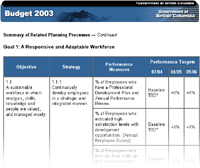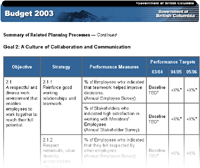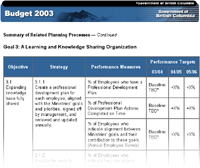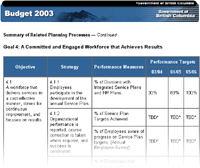 |
|
Summary of Related Planning ProcessesMajor Capital ProjectsCommitments or anticipated commitments for 2003/04 have been made to the following major capital projects:
The objective of these projects is to provide high-quality public health care services that meet patients' needs. The risks associated with these projects include: project delays; changes in market conditions; scope, design and technology changes; building code changes; and cost-sharing agreements with other jurisdictions. As in 2002/03, the Ministry's three-year capital spending plan includes:
Information Resource Management Plan (IRMP)Since the establishment of the Information Management Group (IMG) in 1996 as the information technology (IT) service provider for health, IMG has offered a full range of services to all program areas. IMG has focused on information management and resource planning, establishing standards, and applying industry-proven methodologies and project management techniques to all systems projects. As a result, IMG is now recognized as a centre of excellence in many areas not only by its peer groups among the B.C. Government ministries but also at inter-jurisdictional levels. Funded by the Ministry of Health Services, IMG is constantly challenged by the New Era commitment to e-health, the increased demand on using technology, and its own decreased funding. To meet these challenges, IMG has had to reexamine its priorities and focus its limited resources on initiatives that can best advance government objectives and ultimately benefit patient care for British Columbians. IMG is making a strategic transformation from a full service organization to one that focuses on planning, partnership building, standards setting, business consulting, information services and e-health for the province. Some of the common IT operational functions such as e-mail, desktop and network infrastructure are now delivered through a shared services model within the government. Mandate of the Information Management GroupIMG supports the vision and goals of the government and the two health ministries by fulfilling the following mandate: IMG is responsible for providing provincial leadership in the planning and deployment of health information management strategies, policies and standards through collaboration with key stakeholders at the regional, provincial, inter-provincial and national levels. IMG works to promote cost-effective electronic service delivery solutions and electronic information integration across the health sector within a shared services framework. For the two health ministries, IMG is also responsible for ensuring that effective, quality and value-added products and services are in place to enable the business success of our clients. Main functions include IM/IT planning, standards setting, privacy and security services, business consultation, project management expertise, information services and knowledge management. Major Initiatives and ProjectsStrategic and Tactical IM/IT Planning — Working with the health authorities through the Health CIO Council, the IMG is establishing and implementing a unified IM/IT vision, set of strategies, and collaborative mechanisms to advance e-health objectives. This supports delivery of health care and sustainability of the health system. Electronic Health Record (EHR) — Lead and coordinate health sector-wide EHR activities for the secure sharing of personal health information to support individual health-care decisions by health care providers. British Columbia's tactical approach will be collaborative and guided by common priorities of the health ministries and the health authorities. It will be based on provincially accepted standards, and its progress will be evolutionary. Network Harmonization — A foundation piece for e-health, this project will see the health ministries and the six health authorities working together on a number of network issues including access management, firewall and VPN standardization, wireless security, secure messaging, and strong authentication. Electronic Medical Summary (e-MS) — Sponsored by the Health CIO Council and funded by the Primary Health Care Transition Fund (PHCTF), the project will provide key patient health information to authorized primary care providers to assist with shared care of patients. Main deliverables by the end of March 2006 include a minimum dataset standard for e-MS, an e-MS software application and implementation at pilot health authority sites, a plan for province-wide rollout, and participation in the PHCTF evaluation. Unique Client Identification — A key building block for EHR, client registry service enables the accurate, consistent, and unique identification of clients. Underlying this approach will be an enterprise master patient index to rationalize multiple identifiers to enable accurate personal health information transfer across regional boundaries. Provider Registry — A key building block for EHR, the Provider Registry is a standard-based repository of core data on health care providers. Phase one of the project was jointly funded and developed by the four western provinces and Health Canada. The health ministries are seeking a partnership with Canada Health Infoway Inc. to add additional functionalities to the system to allow for deployment in pan-Canadian health care settings through HL7 standards, add additional care providers' data and consumers of the data, and resolve consent mechanism issues. Health Information Standards — B.C. has been a leader in establishing standards for health information sharing and systems interoperability. Some of the B.C. standards have been adopted by other jurisdictions. Through the British Columbia Health Information Standards Council, the health ministries, health authorities, and other health partners will continue to identify and develop standards needed for e-health for the province, and to address standards deployment issues. Common Authentication — Health care information requires a higher standard of authentication to ensure protection of privacy. The health ministries, the health authorities, and other publicly funded agencies share a need to electronically deliver information to health care providers. This project will identify critical requirements among the stakeholders, review options, seek industry comments, and offer a solution through public tender that will serve the health sector's needs for strong, multi-factor authentication credentials. Chronic Disease Management (CDM) — The objectives of CDM are to develop products to support and measure the improvements in care for people with chronic diseases, and to increase access to health information and services through technological innovations. Products already in place are: a provincial web site to distribute B.C. knowledge and experience in CDM, a provincial patient registry for diabetes, and a preliminary patient registry for congestive heart failure. Current and planned initiatives include a secure website to provide physicians with administrative data to help them identify the level of care for their patients, and registries for depression, hypertension, asthma and co-morbidities. ConclusionInformation Management/Information Technology plays a key role in accessing, processing and disseminating health information to support the day-to-day operation, administration, management and long-term planning of the health system. IM/IT is increasingly seen as a necessary investment and an essential tool for achieving the Government's commitments to e-health, e-government and public accountability. Although the current budget reality poses significant challenges to delivering the much-needed services, IMG will continue to be innovative in meeting those challenges. Deregulation Plan SummarySignificant efforts to reduce the regulatory burden in the health sector are limited by the need to preserve those regulations which are essential to the protection of public health and safety. Overall, it is projected that the Ministry will achieve a regulatory reduction of 25% by June 2004. While the reduction in 2003 will be modest at about 5%, there is expected to be a further reduction of approximately 20% in 2004. The Ministry is continuing its review of regulatory requirements in the health sector and intends to reduce them in order to streamline decision-making and improve the delivery of health services. Major regulatory reviews resulting in statutory, regulatory and policy amendments are being completed in the area of the Community Care and Assisted Living Act, Hospital Act, Food Safety Act, Drinking Water Protection Act, and the Medicare Protection Act. It is anticipated that a proposed updating and consolidation of health services legislation will also result in a significant reduction of regulatory requirements in the health sector. During 2004/05 and 2005/06 the ministry will continue to adhere to the principles of deregulation in its legislative agenda and in the development of new policy requirements. Human Resource Management Plan (HRMP)The Ministries of Health Planning and Health Services recognize that to achieve the strategic objectives detailed in our Service Plans, additional effort and energy must be focused on developing and supporting our employees, our most valuable resource, and continuing to build an enriching, rewarding and flexible organization. We have developed our Human Resources Management Plan to address these issues and act as a guide for all Ministry of Health Planning and Ministry of Health Services employees in planning, undertaking, and evaluating our human resource and organization development activities. This plan has been developed to both support and build upon the 'Corporate Human Resource Plan for the Public Service of British Columbia' and 'BC Public Service Renewal Project', both of which were introduced this year to address issues facing British Columbia's Public Service. The ministries have developed four rebuilding themes that will guide us through the delivery of this Human Resources Management Plan: Building, Connecting, Learning, and Performing. The goals for each of these themes are as follows: 1. Building: A Responsive and Adaptable Workforce 2. Connecting: A Culture of Collaboration & Communication 3. Learning: A Learning and Knowledge Sharing Organization 4. Performing: A Committed and Engaged Workforce that Achieves Results Building — The Foundation for SuccessWe must build an organization that welcomes change — using it as an opportunity for innovation, improvement, and the excitement of a good challenge!
Connecting — Collaboration is the Key to InnovationTo deliver on our aggressive strategic agenda we will harness the ingenuity, knowledge, skills, and energy of the entire organization.
Learning — The Key to Ongoing SuccessThrough continual learning, our organization will be a model from which other organizations can learn. It is our responsibility to ensure that learning opportunities are available to our employees, and that they have the opportunities and support to apply and integrate new skills and knowledge in the workplace.
Performing — The Outcome of a Strong OrganizationPerformingThis goal is built on the philosophy that strong individual and organizational performance is achievable if our employees are provided with the direction, support, encouragement, and working environment that allows them to reach their potential.
|
||||||||||||||||||||||||||||||||||||||||||||||||||||
|
|||||||||||||||||||||||||||||||||||||||||||||||||||||




